PC enthusiasts following the gladiatorial match between AMD and Intel for the past few years have regularly enjoyed the fruits of this intense competition. It has led to remarkable changes in the CPU industry, including the addition of more CPU cores, hybrid architectures, and 3D V-Cache, among countless others. All of these changes, in one way or another, have made processors faster for both gaming and productivity. The latest release from Intel comes in the form of the 13th-Gen Raptor Lake desktop CPUs, and it seems to be a preemptive strike designed to dull the AMD party, who recently came out with the Zen 4 Ryzen 7000 processors. But how do the new Intel 13th-Gen processors stack up against the Ryzen 7000 series? Is it a home run or merely a bunt? Let’s find out in this detailed explainer about the newly launched Intel 13th-Gen desktop processors.
Intel 13th Gen Raptor Lake CPUs (2022)
The Raptor Lake announcement has presented us with some fascinating details about what Intel wants to do with their new desktop CPUs. In this article, we will explore all the important aspects of the release, from looking at changes in the architecture to pricing and more. This period might just be the most exciting time for a PC fan in over a decade, as multiple battles are taking place all over the industry.
And with the CPU market being this interesting, we wouldn’t want you to miss any information about it. So, here is everything you need to know about Intel’s 13th-Gen CPUs. Let’s dive in.
Intel 13th Gen CPU Models and Specifications
Now before we have a look into the details of the Intel 13th-Gen architecture, let us start with a general overview of the entire CPU lineup. For now, Intel has only released details for six processors from the entire lineup, but they have reiterated that there will be 22 desktop-class processors in total. That said, let’s look at how the announced CPUs are differentiated below:
Processor Name Processor Cores / Threads Cache Size (L3/L2) Turbo Frequency (P/E) Base Frequency (P/E) Base Power
(in watts)Est. Price Core i9-13900K 24 (8P, 16E) / 32 36MB / 32MB 5.8GHz/ 4.3GHz 3.0GHz/ 2.2GHz 125W $589 Core i9-13900KF 24 (8P, 16E) / 32 36MB / 32MB 5.8GHz/ 4.3GHz 3.0GHz/ 2.2GHz 125W $564 Core i7-13700K 16 (8P, 8E) / 24 30MB / 24MB 5.4GHz/ 4.2GHz 3.4GHz/ 2.5GHz 125W $409 Core i7-13700K 16 (8P, 8E) / 24 30MB / 24MB 5.4GHz/ 4.2GHz 3.4GHz/ 2.5GHz 125W $384 Core i5-13600K 14 (6p, 8E) / 20 24MB / 20MB 5.1GHz/ 3.9GHz 3.5GHz/ 2.6GHz 125W $319 Core i5-13600KF 14 (6p, 8E) / 20 24MB / 20MB 5.1GHz/ 3.9GHz 3.5GHz/ 2.6GHz 125W $294
Starting from the top, the first processor we will be looking at is the flagship Intel Core i9-13900K, which was the center of attention at the announcement. It comes with 24 cores in total with 8P cores (performance) and 16E cores (efficiency). The i9-13900K distinguishes itself from the previous-gen flagship i9-12900K, as it has 8 more efficiency cores than the latter. It is also clocked significantly higher than the 12900K with a max boost speed of 5.8 GHz. This is almost 600 MHz more than the 12900K, and as we will see in our performance section, it does lead to some impressive improvements.

The next CPU in the lineup is the Core i7-13700K, which comes with 16 cores in total (8P and 8E cores). Just like the i9-13900K, Intel Core i7-13700K also gets extra Efficiency cores (bumped up from 4 to 8 cores), along with a similar 0.6 GHz clock speed boost. Priced at around $400, a bit lower than the 13th-Gen Core i9 models, the i7-13700K seems to be the CPU that will be this generation’s “bread and butter” gaming processor. Its 16 cores will be a sweet spot to give optimal performance in video games for at least a few years.
The story is once again similar when we come to the latest 13th-Gen Intel Core i5-13600K. The core count sees a slight uptick with the addition of four new E cores and a bump in clock speeds to 5.1 GHz. With 14 cores, the 13th-Gen i5 desktop CPU will make for a good all-round mid-range processor that will be able to handle most tasks with ease. We believe that this will be a popular pick for budget gamers and those looking for a slight upgrade in processing power.
Intel also showcased the “KF” version of the aforementioned chips, which come without integrated graphics – Core i9-13900KF, Core i7-13700KF, and Core i5-13600KF. Other than the fact they come without an iGPU, they mostly share the same basic specifications and are slightly pricier than the “K”-series chips.
Intel 13th-Gen CPU Architecture
Now that you are familiar with the new models, let’s look at the Intel 13th-Gen CPU architecture. Almost every year, like clockwork, Intel rolls out a new processor generation that is a little bit more powerful than the earlier version and a little more efficient. However, with the introduction of Alder Lake CPUs last year, Intel made a much larger shift than usual and debuted an entirely new chip architecture.
Intel’s 12th-Gen moved away from using a single class of processing cores to a more mobile-style ARM-based approach with a new hybrid architecture. That means the processor cores were divided into two different categories, with one promising to deliver higher performance called the P cores and another type of core that was optimal for energy-efficient tasks called E cores. The idea behind this approach was to deliver better performance, but at the same time, offer the capability to tackle easier tasks like video streaming in the background using efficiency cores.
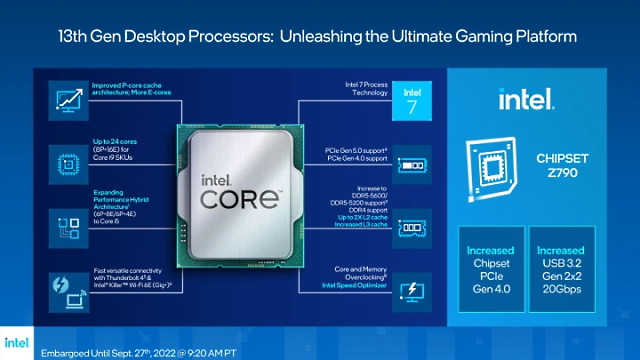
With the 13th-Gen processors, however, we don’t see any fundamental shift in the manufacturing process. Intel’s 13th-Gen CPUs use the same Intel 7 process (Intel’s in-house 10nm manufacturing process) that was used for the 12th-Gen processors. No, the company is yet to catch up to AMD, who is using a 5nm process node for their latest Ryzen 7000 processors.
According to Intel, it has refined the existing 10nm process node in subtle ways. Though, in the architectural sense, it’s the same. All Raptor Lake CPUs still use the same big.LITTLE hybrid approach as the Alder Lake processors, with individual cores being split into performance (P) cores and efficiency (E) cores.
Does sticking to the same architecture mean that nothing has improved? Not really. The manufacturing improvements, for one, have led to some genuine upgrades. Intel stated that because of architectural tweaking, they have been able to optimize the core voltage as frequency increases, which has led Raptor Lake processors to hit higher clock speeds than their Alder Lake counterparts. This is evident in the specifications chart, as the new 13th-Gen CPUs have higher clock speeds across the board.
The other big change for this generation of Intel CPUs comes in the form of the increased CPU cache. The new design offers 2MB of L2 cache per P-core, and up to 4MB per E-core cluster, which is double of what was available on Alder Lake chips. Intel claims that these cache changes will have a huge impact on the level of performance as cache plays an important role in tasks like gaming. AMD has shown us that this is true when they released their Ryzen 7 5800X3D processor, which on paper was similar to the Ryzen 5800X, but the additional cache size was able to push the CPU to new heights in terms of gaming performance.
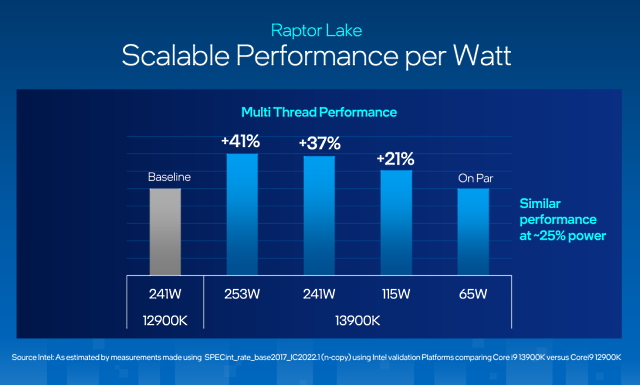
The architectural improvements have also led to some impressive efficiency gains. A graph presented by Intel (attached above) shows that the Core i9-13900K seems to deliver a similar level of multi-threaded performance to the i9-12900K, at only 65 W, which then increases to 41% at the maximum power consumption of 253 watts. The maximum power consumption of the 13th-Gen i9 chip is a tad higher than the previous-gen, but the fact that Raptor Lake can keep up with Alder Lake when consuming 3x less power is impressive.
Intel 13th Gen Processor: New Features
Now that we have looked at hardware improvements, let’s talk about the additional features that the new 13th-Gen Raptor Lake processors bring in tow. Since the architecture is rather similar, Intel has not included many new features but has enhanced many of the previous ones found in their Alder Lake CPUs. Let’s have a look:
Intel Thread Director 2
The first feature we will look at is Intel’s new Thread Director 2 tech. What is it, you ask? Thread Director is a hardware-based technology that provides enhanced telemetry data to the Windows scheduler, which then intelligently distributes workloads to the optimal cores. It’s a feature that Intel first released with their 12th-Gen processors to help make the best use of their “Hybrid” architecture. But as many tech experts claim, it didn’t work as well as it should have.

With the 13th Gen CPUs, Intel has made important changes to the Thread Director, and according to a recent hands-on video by PCWorld, the new version of Thread Director seems to perform better, as it is shown to intelligently and rapidly adapt to different kinds of workload. The Intel representatives, however, pointed out that users should be on Windows 11 to make optimum use of this feature, as Windows 10 does not support Thread Director.
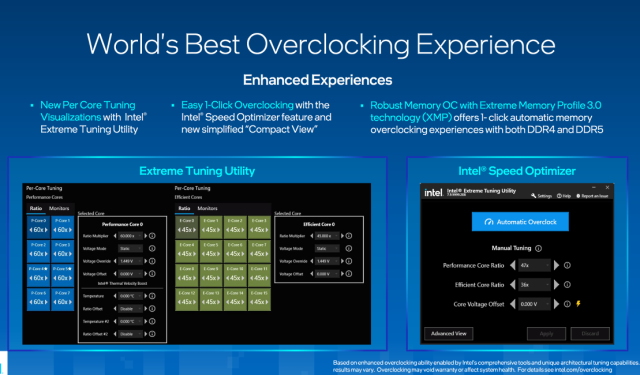
Updated Intel Extreme Utility
The other impressive feature that sees an upgrade is Intel Extreme Utility, which can now be used along with Intel’s Speed optimizer for easier overclocking. Intel claims that overclocking no longer has to be this complicated task that can only be achieved by tech savvies, but a feature that is accessible to all. There is also enhanced support for Intel’s XMP 3.0, which makes overclocking the memory as simple as overclocking the CPU.
Intel 13th Gen: Performance
Coming to the performance, we have some estimates of how powerful the new Intel 13th-Gen processor will be, thanks to the several graphs Intel showed off at their announcement. Most of the graphs that Intel showed highlight that the 13th-Gen chips are going to be much faster in gaming and content creation than Zen 3 (yeah, Zen 3 and not Zen 4 as they are not yet available in the market for them to test) and Alder Lake chips. But by how much exactly?
There are many ways in which you can compare the performance of a processor, but the way Intel has tried to break it down is by looking at performance improvements that the new Intel Core i9-13900K see against the i9-12900K, Intel’s previous-gen flagship, and AMD’s last-gen flagship chip, the Ryzen 9 5950X.
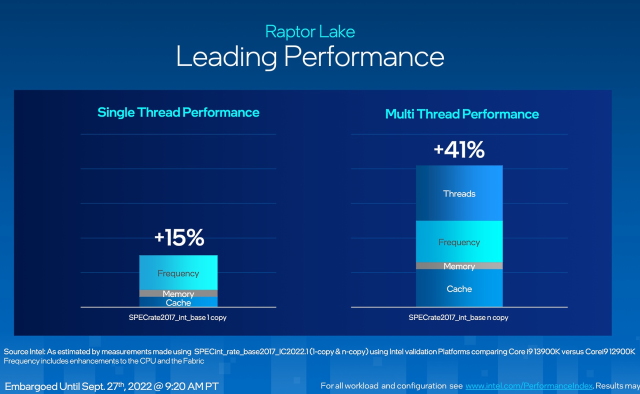
In most scenarios, as claimed by Intel, the Core i9-13900K delivers 15 percent better performance in single-threaded applications. But it can go up to 41 percent in multi-threaded tasks over the Core i9-12900K. In a fascinating graph breakdown, Intel further shows us that the difference in single-threaded performance comes from a variety of aspects such as an increase in clock speeds, upgrades in memory speeds, and the addition of extra cache. Whereas the multi-threaded improvements come primarily from the increase in core counts (extra efficiency cores) and boost in frequencies.
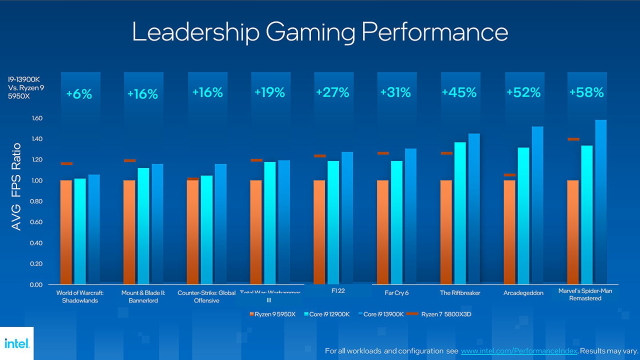
Let’s talk about the gaming performance of Intel’s 13th-Gen processors next. In a gaming performance graph shared by Intel, we can see that improvements in both architecture and clock speeds have led to a performance advantage anywhere from 6% in some games like World of Warcraft to over 58% in others like Marvel’s Spider-Man Remastered over AMD’s last-gen flagship Ryzen 9 5950X. The performance upgrade is impressive, as 5950X was already a monster in games, so a 50% upgrade over an older-generation flagship is nothing to scoff at.
But as they say, the devil is in the details. Firstly, when compared to the Ryzen 5800X3D (AMD’s gaming flagship), the performance uptick is minimal and lower in some games like World of Warcraft. Now we do know that 3DV cache does at times inflate gaming frame rates, but the fact the new 13th-Gen i9-13900K is still struggling to beat AMD’s last-gen architecture does not bode well for the flagship CPU when it goes up against AMD’s newerRyzen 7000 series in comparison reviews.
Furthermore, in a rather interesting video, Linus from LTT points out that the memory configurations Intel used for this comparison were widely different across the CPUs. Intel used a 3200 MHz DDR4 kit for the Ryzen CPU, while they used an over-clocked 5600 MHz DDR5 kit for their own i9-13900K Raptor Lake CPU. The differences in memory speed have been known to have susceptible performance impact for some time now. Linus argues that the huge difference in performance could be a result of higher memory clock speeds and could have been mitigated if Intel would have used a slightly higher clocked RAM, maybe something closer to 4000 MHz. Check out the video if you want to see the complete breakdown.
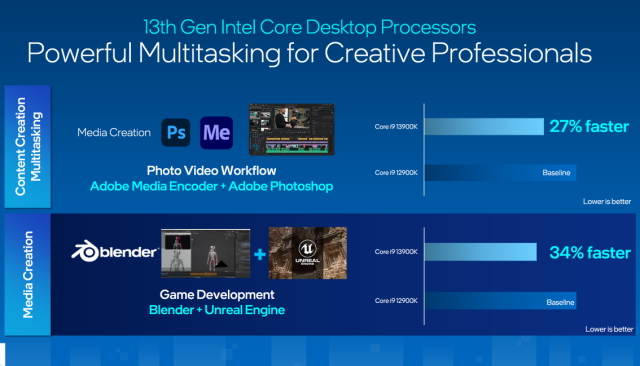
Apart from gaming, Intel also shared that creative professionals will also see some benefits if they upgrade to the new 13th-Gen processors. Intel claims that the 13th-Gen i9-13900K will be 27 percent quicker than i9-12900K in photo-video workflow applications like Adobe Media Encoder and Adobe Photoshop. And up to 34 percent faster in game development applications like Blender and Unreal engine.
Intel 13th-Gen Raptor Lake Motherboard and Chipset
During the announcement, Intel also showed us the new motherboard chipset that will accompany the 13th Gen processors – the Z790. At the outset, it doesn’t seem like a significant upgrade from the previous-generation Z690 motherboards, but Intel has revealed that there are some small improvements in the chipset.
For one, the new Z790 chipset now sports a total of 20 PCIe 4.0 lanes, which is eight more 4.0 lanes than the Z690. There’s also the addition of increased memory support as the new chipset will support DDR5 RAM speeds up to 5600 MHz, which is 800 MHz more than the Alder Lake chipsets could achieve. Finally, we also see an additional 20 Gbps USB 3.2 port, which moves the maximum number of 20 Gbps USB ports to five.
We have more good news for existing Intel users. The new 13th-Gen Intel CPUs use the same LGA1700 socket as the previous 12th-gen processors, so most Z690 motherboards will be able to support the new chips. This backward compatibility is a good move from Intel, as until now, they have drawn criticism for ditching platforms just after a year or two.
Also, Intel announced that the new chips will be compatible with DDR4 memory and that DDR5 memory is not a necessity. So, if you think the eight additional PCIe lanes are not something that you need, you can continue with your Z690 board and your old DDR4 RAM. And in most cases, you will not see any performance difference.
Intel 13th-Gen Processors: Price
Now that we have covered the specifications and performance, it is time to move on to the more interesting aspects. Many of you must be wondering – How much will the Intel 13th-Gen Raptor Lake CPUs cost and when will they be released? Well, here’s the answer.
The prices of the latest Core i9-13900K and Core i7-13700K chips are, to many pundits’ surprise, the same as last year. This is something that was not expected as Intel themselves had warned of an impending price increase. The price increase was set to be caused by the rapid decline that PC shipments have experienced in the last year, along with the rapid inflationary pressure impacting costs all over the world.
But as we saw with the announcement, the prices have mostly remained the same. Intel Core i9-13900K will retail at $589, which is the same price as that of 12900K. Similarly, the Core i7-13700K will retail at $409, the same price as the 12700K.
The Core i5 lineup of processors is the only one getting a price bump, with the Core i5-13600K coming up at a retail price of $319, a $30 uptick from the similarly specced Core i5-12600K. Similarly, the Core i5-13600KF (without built-in graphics) will sell for $294, up from the $264 of last year’s model. The prices, though, in the end will depend on demand, so if the processor turns out to be popular, do expect the price to fluctuate.
Now what this means for the lineup as a whole, we can’t be sure. But keeping in mind that the Core i5 processors have seen a small uptick in price, there is a possibility that there will be a price increase in the lower-end Core i5 and Core i3 models in the future. But for now, the pricing structure looks something like this:
- Core i9-13900K — $589
- Core i9-13900KF — $564
- Core i7-13700K — $409
- Core i7-13700KF — $385
- Core i5-13600K — $320
- Core i5-13600KF — $295
Intel 13th-Gen Processors: Release Date
As for availability, Intel has stated that the first six 13th-Gen K-series desktop processors and the Z790 motherboards will be available to buy starting 20th October. Intel also said that this release date will apply to pre-built desktop systems, which will be sold by third-party OEMs like MSI, Asus, and many others. The release date for the other 16 desktop processors has still not been announced till now, but we presume, it is going to be sometime early next year.
Intel 13th-Gen Raptor Lake Processors Detailed
Intel has been in great form for the past two years, after being taken by surprise by AMD at the tail end of the 2010s. There was a time when AMD had a lead over Intel in every aspect from the newer manufacturing process to core counts. AMD was set to dominate Intel in the chip market, and for a while, they did. But with the coming of the 12th-Gen Alder Lake CPUs, Intel hit back and took the lead in both gaming as well as productivity performance.
With a radical change in architecture, Intel has been able to show that even they can innovate (even though they are still stuck on the 10nm process node). This year, however, things seem to be more muted as the 13th-Gen Raptor Lake CPUs seem to bring minor updates over the Alder Lake CPUs, rather than a generational one. With that said, Intel has shown us that their new chips are quite a bit faster than last year and are ready to face their nemesis, the AMD Ryzen 7000 series, in the coming months. It’s a great time to be a PC enthusiast, and we can’t wait to see how this battle plays out in the coming few months. So what are your thoughts on Intel’s new 13th-Gen Raptor Lake CPUs? Did they live up to your expectations? Let us know in the comments below.













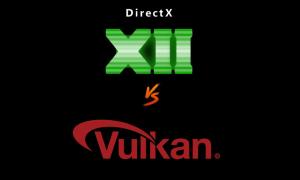
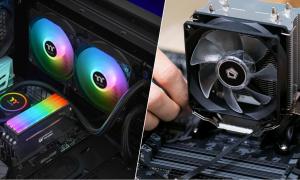

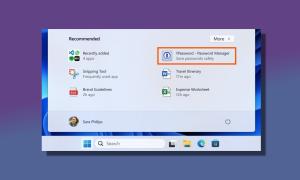

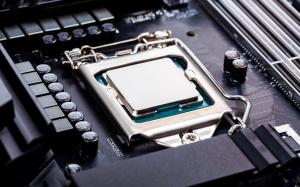
Editorial comments:
The basic table at the start repeats Core i7-13700K in the left-hand column, the second row for this entry should be Core i7-13700KF.
Sentence: “Other than the fact they come without an iGPU, they mostly share the same basic specifications and are slightly pricier than the “K”-series chips.” should say “slightly cheaper (-$25) than the “K” series chips.”
Hope this helps. Good info, covered the highlights well, without being a too long too technical read!